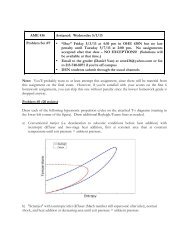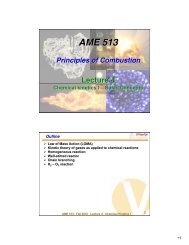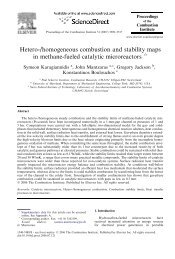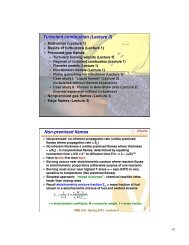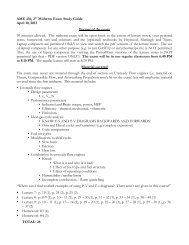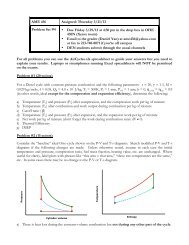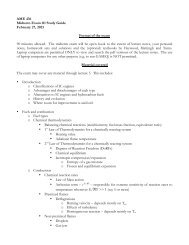AME 436
AME 436
AME 436
You also want an ePaper? Increase the reach of your titles
YUMPU automatically turns print PDFs into web optimized ePapers that Google loves.
Example (continued)"<br />
f) Thermal Efficiency<br />
η th = (Net work per unit mass) / (Heat input per unit mass)<br />
= (Net work)/fQ R = (1.089 x 10 6 J/kg)/(0.05)(4.45 x 10 7 J/kg) = 0.489 = 48.9%<br />
compare this to the theoretical efficiency (should be the same since this is an ideal<br />
cycle analysis)<br />
" th<br />
=1# 1 & % $ #1 ) 1 & 3.43 1.3 #1 )<br />
( + =1# ( + = 0.489 = 48.9%<br />
r $ #1 ' $ (% #1)<br />
* 20 1.3#1 ' 1.3( 3.43 #1)<br />
*<br />
g) IMEP<br />
!<br />
!<br />
Net work<br />
IMEP = =<br />
V d<br />
(Net work)/mass<br />
=<br />
V d<br />
/mass<br />
Net work/mass<br />
= "<br />
V d<br />
/(" 2<br />
V d<br />
)<br />
2<br />
(Net work/mass)<br />
P<br />
# IMEP = 2<br />
1.089 %10 6 J /kg<br />
(Net work/mass) =<br />
=12.7atm<br />
($/ M)T 2<br />
[(8.314J /moleK) /(0.029kg /mole)](300K)<br />
1atm<br />
Note that the mass does not include the mass in the clearance volume; it is<br />
assumed that this mass is inert (i.e. exhaust gas) which does not yield additional heat<br />
release, plus its compression/expansion work cancel out<br />
<strong>AME</strong> <strong>436</strong> - Lecture 8 - Spring 2013 - Ideal cycle analysis<br />
37<br />
Examples of using P-V & T-s diagrams"<br />
Consider the “baseline ideal Diesel cycle shown on the P-V and T-s diagrams. Sketch<br />
modified diagrams if the following changes are made. Unless otherwise noted, assume in<br />
each case the initial T & P, r, f, Q R , etc. are unchanged.<br />
a) The compression ratio is increased (same maximum volume)<br />
Equal<br />
areas<br />
The minimum volume must decrease since r increases but the maximum volume does not.<br />
The cutoff ratio = 1 + fQ R /C P T 2 r γ-1 decreases. The temperature after compression T 3 as<br />
well as the maximum temperature T 4 = T 3 + fQ R /C P increase. In order to maintain equal<br />
heat addition and thus equal areas on the T-s diagram, s 4 decreases.<br />
<strong>AME</strong> <strong>436</strong> - Lecture 8 - Spring 2013 - Ideal cycle analysis<br />
38<br />
• 19





